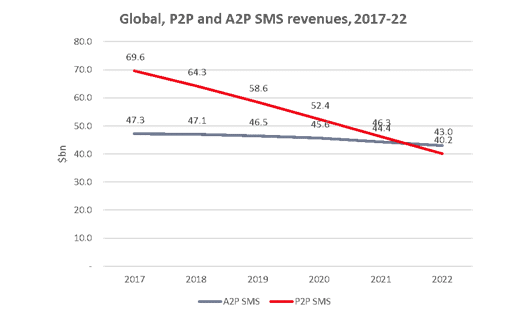No task is more fundamental for any business or organization than finding a sustainable revenue model. And the task is doubly important whenever any successful revenue model is under attack. And that is the case for most firms, in most industries these days.
In the computing, retailing, lodging, travel, transportation, software, communications and media industries, business models--all the functions any company or organization must undertake to sustain its business or mission--have changed over the last 20 years.
And chief among the changes is the task of discovering” a revenue model, either to replace a dying source or create one for a “free to use” application. Text messaging (short message service) and provide an obvious examples.

source: Ovum
The same problem exists with mobile voice. As subscribers grow, and usage grows, revenue has remained flat, or shrunk. By 2021, Ovum researchers have predicted, fixed network voice will represent only about 7.7 percent of total global telecom revenues, compared to mobile at 59 percent of total.
Fixed network broadband will represent 18 percent of total revenues, while subscription TV represents about 15 percent of total revenues.
The global telecoms & media market will generate $1.58 trillion in revenues in 2021 from 11.96 billion connections, according to Ovum, which counts fixed network, mobile network and video services in its tally.

source: techneconomyblog.com
For mobile operators, the devastation of text messaging revenue drives the effort to create new roles for text messaging as a business-to-consumer marketing platform. In many instances, unlimited use of domestic text messaging has become a feature of a mobile subscription, and not a direct revenue source.
“Unfortunately for most telcos, P2P SMS has become essentially valueless, since they have had to bundle unlimited SMS into mobile tariffs to remain relevant to their customers, an increasing number of whom use chat apps such as WhatsApp, WeChat and Facebook Messenger,” said Pamela Clark-Dickson, practice leader of Ovum’s Communications and Social team.
For Facebook, the effort is to monetize WhatsApp without relying on advertising, Facebook’s traditional revenue model. And Facebook believes it can create e-commerce, payment and marketing service revenue using WhatsApp, without relying on advertising.
Though it once was unthinkable that a market-leading software company could base its revenues on advertising rather than sales of shrink-wrapped software licenses, it has happened. But reliance on a single revenue model will strike most executives as risky, especially if there are customer objections and there are other viable additional models.
So it is that Facebook is working to monetize personal messaging as part of a broader effort to create a marketing and commerce platform that makes money as a “platform” connecting merchants and customers, instead of messaging remaining a person-to-person communications function.
That is the same application-to-person business mobile operators and app providers are trying to create with text messaging, as global text messaging revenues fall.
The issue, as always, is whether text messaging can be built into a platform, as Facebook hopes WhatsApp--combined with other Facebook resources--hopefully can become. At this point, few likely believe mobile operators are positioned as well as Facebook to create such a platform.
But the effort must be made, if mobile operators hope to stem the erosion of text messaging revenues overall. And that is a core business model issue.
